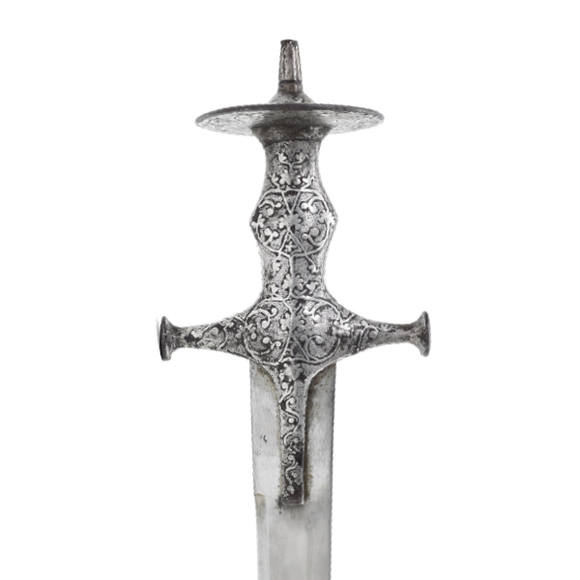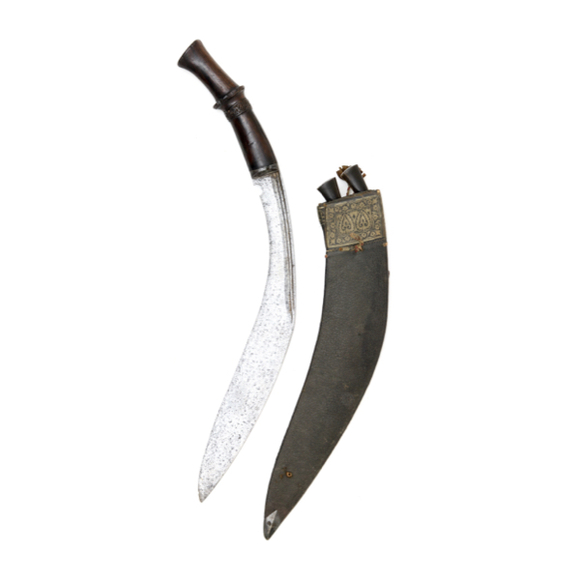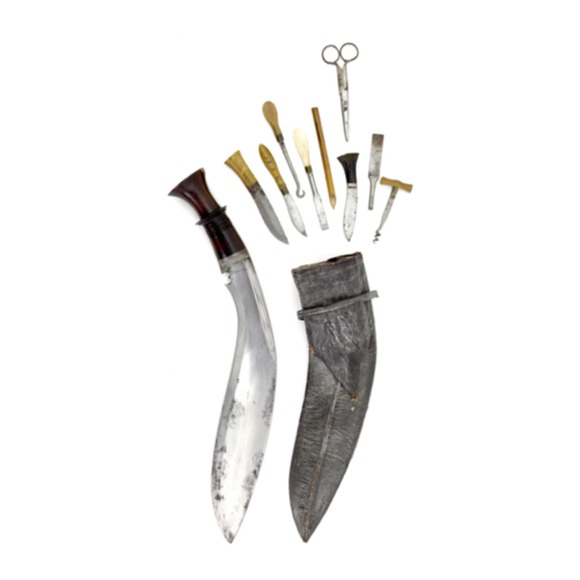The hilt is in the typical Marwari Rajput style, made by Ram Namar in 1857 A.D.

91 cm
79.7 cm
Base 5.6 mm
Middle 3.9 mm
Start backedge 3 mm
Base 37 mm
Middle 37 mm
Widest at tip 44 mm
1231 grams
19 cm
(from center crossguard)
Iron, steel, gold, resin
North India, probably Lahore
Hilt dated 1838
From a Dutch collector
Description
A large and impressive Punjabi talwar. The blade of Persian form with long, sharp backedge and rounded spine. The ricasso, however, betrays an Indian origin. In its current state the construction method of the steel cannot be ascertained, but it is at least free of forging flaws of any kind. This either indicates that it is wootz, or an extremely well-made laminated blade. It has two cross-shaped stamped marks, one on each side, and a square cartouche on the right side under the langet.


Hilt
The hilt is of typical Punjabi style with some cross-over elements from Delhi; It is larger than most and of strong proportions, with a wide grip section and large disc pommel that tends towards Delhi-style hilts. Its quillons are forward inclined, and it has a strong knuckle bow with lotus bud finial, the latter both typical Punjabi design elements. The hilt is entirely covered with fine raised gold koftgari work in the style of Lahore.

The blade is secured into the hilt by means of resin and an additional rivet that goes through the blade. Some of the resin has since gone, so the rivet can be seen when looking into the hilt.

Inscription
On the inside of the knuckle guard is a long inscription in Gurmukhī script:

"A gift, though dangerous, for Guru Kartarpuri by Sukhu Singh 1895"
1895 Samvat works out to 1838 A.D., well into the short-lived Sikh Empire that lasted from 1799-1849.
Sukhu Singh
Looking into Sikh history, only one Sukhu Singh turns up, probably the one mentioned on the sword.
Originally from a small village named Rai, just south of Lahore. He became a protegé of Baghel Singh (1730-1802), a notable Sikh general and leader of the Panjgarhia Misl, one of the sovereign states of the Sikh Confederacy. Baghel Singh once led an army of 30.000 and entered Delhi on the 11th of March, 1783. He struck a deal with the Mughal Emperor to take 12,5% of all Delhi tax, in exchange his Sikhs would not attack the city again.
It is unclear exactly when they met, but Sukhu Singh received Sikh baptism at Baghel’s hand and became his officer and attendant. When Baghel Singh moved to Panipat he made Sukhu Singh chief go Rohtak, Jind and Gohana, the general area northwest of Delhi.
Sukhu Singh eventually rebelled against Baghel Singh, who imprisoned him for 5-6 days but then pardoned him. He was granted a doshala (shoulder mantle), a horse, and his authority over his territory was restored. The two men must have had a rather special relationship, for Sukhu to be getting away with this on such favorable terms.1
When Baghel Singh passed away, Sukhu Singh came to Hariana to mourn him and to look after Baghel’s two widows. He found the Panjgarhia Misl in disorder and proclaimed himself the successor of Baghel Singh. The Misaldars and Tabedars (cavalrymen) initially accepted the claim. The Sardards (nobility) disagreed, leading to a rift in the state and some of the Misaldars revolted and declared themselves independent. Sukhu Singh sided with the elder widow and eventually occupied Talwan fortress.2
The Misl was eventually controlled by Rattan Kaur, the younger of Baghel Singh’s two widows, until her death in 1848, after which the area came under British control as the Kalsia princely state.
Sukhu Singhs eventual fate appears to be unknown, the last mention of his name is in 1844 as a Sikh military commander.3
If he was 20-30 when he met Baghel around 1800, he was 64-74 by 1844.
References
1. Punjab District Gazetteers, Volume XIV A. Jullundur District, with maps, 1904. Page 35 and Baldev Raj Sharma; Punjab District Gazetteers: Jullundur. Chandigarh, Revenue Department, 1980. Page 36. Both drawing heavily from Ghulam Muhayy-ud-Din alias Bute Shah; Tawarikh-i-Punjab, 1848.
2. DiscoverSikhism.com; History Of The Sikh Misals. Sukhu Singh Pohli.
3. Prakash K. Shastri; Organisation Militaire Des Sikhs. L. Rodstein, Paris. 1932. Page 114.
Guru Kartarpuri
The meaning of this is less clear. There is a Sikh manuscript from Kartarpur, sometimes called Guru Kartarpuri, but it would be weird to present a sword with a personal message to a scripture.
However Kartarpuri is also a town, and the term Guru was used much more loosely back then than it is now. So it most likely was a present to someone in Kartarpuri that Sukhu Singh respected.




















With a very fine Nepalese blade, but kard-like hilt and scabbard.
Early type with very shallow notch in the blade and little flare in the pommel.
20th century military khukurī with many different tools in its back pocket.






